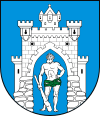 Alternate names: Prabuty [Pol], Riesenburg [Ger]. 53°46' N, 19°13' E, 46 miles SSE of Gdańsk (Danzig), 27 miles NE of Grudziądz. Jewish population: 148 (in 1895), 70 (in 1925). Słownik Geograficzny Królestwa Polskiego (1880-1902), IX, pp. 9-10: "Prabuty". A town in Kwidzyn powiat within the Pomeranian Voivodeship in northern Poland. From 1975 - 1998 ,Prabuty were part of the Elbląg Voivodeship. Prabuty is an important rail junction on the Warszawa - Gdynia railroad and forty miles south of the Gulf of Danzig. [June 2009]
Alternate names: Prabuty [Pol], Riesenburg [Ger]. 53°46' N, 19°13' E, 46 miles SSE of Gdańsk (Danzig), 27 miles NE of Grudziądz. Jewish population: 148 (in 1895), 70 (in 1925). Słownik Geograficzny Królestwa Polskiego (1880-1902), IX, pp. 9-10: "Prabuty". A town in Kwidzyn powiat within the Pomeranian Voivodeship in northern Poland. From 1975 - 1998 ,Prabuty were part of the Elbląg Voivodeship. Prabuty is an important rail junction on the Warszawa - Gdynia railroad and forty miles south of the Gulf of Danzig. [June 2009]
Little is known about the history of this Jewish community that probably began with one Jewish family in 1700. German: Riesenburg. The kahal was established sometime. In 1831, 69 Jews lived there and 145 in 1895, declining due to immigration until in 1925 when only 70 Jews lived there. Many fled due to Nazi repression. [June 2009]
The date of establishing the Jewish cemetery on the square at ul Jagiello was probably in the 18th century, possibly 1812. A garage fills the site now, built after WWI when the communist authorities destroyed the cemetery. Among the grasses are traces of individual graves. Founded in the nineteenth century, the area of about 0.25 hectare, preserved dozens of tombstones with Hebrew and German inscriptions, the oldest of the 1860. Photos. Photo. [June 2009]
US Commission No. POCE000766
(Alternate name: Riesenburg in German) Proibuty is located in region Elblyskie at 53º46 19º13, 75 km SE of Gdansk. The Jewish cemetery is located on Jagietty Street. Present town population is 5,000-25,000 with no Jews.
- Town: Urzad Miasta i Gminy, 2 Kwidzynska Street, tel. 134.
- Local: Urzad Wojewodzki, ul. Wojska Polskiego 1, tel. 27 001.
- Regional: Panstwowa Sluzba Ochrony Zabytkow, Elblag, ul. Wojska Polskiego 1, tel. 24 553.
The earliest known Jewish community was 1817. 1938 Jewish population was 28. Effecting the Jewish community was Judenedikt of 1812. The Orthodox and Progressive/Reform Jewish cemetery was established around 1812. The isolated suburban flat land has no sign or marker, no wall, gate, or fence. Reached by turning directly off a public road, access is open to all. The 0.2 hectares size of the cemetery before W.W.II is unchanged. No gravestones are visible and no known mass graves. The municipality currently owns site used for recreation and industrial/commercial purposes. Properties adjacent are residential. Local residents visit rarely. The cemetery was vandalized during W.W.II, but not in the last ten years. No maintenance. Garages were built in the cemetery area.
Wiktor Knercer, 10-685 Olsztyn, ul. Bowcza 33/16, tel. 33-86-07 visited the site in June or July 1992 and completed survey in September 1992. Documentation: Mapa w Skali 1:25000 2 l. 1910-1920, Deutches Staedtebuch Erich Renser.
